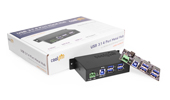USB charging doesn’t always get much attention, but it’s an important part of a medical facility’s IT infrastructure. When employees don’t have adequate options for charging their devices, they may bring in their own cheap chargers or use whatever they find on the road. Charging stations of poor quality and unknown provenance can shorten device life and even endanger security.
The quality of chargers has been steadily increasing, letting users replenish their devices more quickly while maintaining a reliable voltage level. Gallium nitride is one of the newest advances, providing greater efficiency and more compact devices.
When people can leave the medical office with their devices fully charged, they don’t have to hunt for charging stations. They’re less likely to run out of power at an inconvenient time, and they won’t have to expose their employer-issued devices to risky power sources. As with all medical USB devices, insisting on quality pays for itself.
The complexities of charging
It seems that USB charging should be a simple thing. You plug your device in, it draws power, and it charges the battery. In reality, it’s surprisingly complex. With modern USB, a device negotiates the rate it will get power with the source. The USB Power Delivery Specification dictates how this happens, but not all charging ports follow it strictly. Wall chargers typically don’t have any negotiating capability and just deliver 500 mA or less. Some devices require proprietary chargers and won’t draw power from anything else.
The maximum amperage for charging ports depends on the protocol level they support. USB 2 gives a maximum of 500 mA, while USB 3.1 expects devices to make 900 mA available. When both sides can handle it, a device can deliver as much as 5 amperes at 20 volts, i.e., 100 watts.
The USB power specification supersedes Qualcomm’s proprietary Quick Charge, which can deliver up to 20 volts. Traditional devices expect 5 volts. Imitation Quick Charge devices may deliver high power to devices that can’t handle it, risking serious damage or fire.
Drawing more power than a device was designed to take can be wasteful and shorten its life. On the other hand, a needlessly slow charge wastes time. Employees may have to go out with partially charged devices and will need to find a recharge sooner.
USB outlets and security
When security is an issue — for example, with devices holding ePHI — plugging into random USB outlets is risky. Malicious ones can pull information off the device or infect it with malware. The term “juice jacking” refers to attacks through USB charging stations. Some criminals leave chargers loaded with malware in public places. Others have managed to deposit malware into charging stations in shopping malls and airports.
The best approach, from the standpoint of both security and quality, is to use only known, well-made chargers and not let others use them. Carrying a portable charger is safe, not to mention offering more opportunities to plug in. It’s a reasonable investment for employers to include good chargers with devices issued to their staff. In the office, they should have ready access to charging hubs. Replacing old, slow chargers with new, more efficient ones will further improve safety and productivity.
Don’t skimp on hubs and chargers. Good ones safely keep your devices ready to use. Giving medical staff access to them saves them from the temptation of using public chargers or poorly made ones. At the computer, a high-quality hub with surge protection will give users a reliable power source for all their phones and tablets. Ask about all the medical-grade USB devices we have to offer. They’ll give your staff the best experience and protect your investment in equipment.



















